Using Geovisualization Tools to Examine Attitudes towards Alcohol Exposure in Urban Environments: A Pilot Study in Madrid, Spain
Abstract
:1. Introduction
2. Materials and Methods
2.1. Study Settings and Design
2.2. Generation of the 3D Scenes
- -
- Streets and public pathways were downloaded from the Open Street Map (OSM) database (https://www.openstreetmap.org/, accessed on 26 July 2022) in 2017.
- -
- Buildings (including their footprints and heights) were downloaded from the Spanish Land Registry (Cadastre, https://www.sedecatastro.gob.es, accessed on 26 July 2022) in 2017.
- -
- Information on the location of the entrances to the on- and off-premise alcohol outlets (expressed by Universal Transversal Mercator (UTM) coordinates and address) bordering Lavapiés Square were obtained in 2017 from the Municipal Census of commercial and business establishments, available at the Open Database of the Madrid City Council (https://datos.madrid.es/portal/site/egob, accessed on 26 July 2022). The dataset was validated by field observation in 2017. A second validation in 2021 using Google Street View identified that the number of on- and off-premises alcohol outlets had not changed in the intervening time.
- -
- Vegetation information (e.g., trees located within the study area) and urban furniture elements (e.g., benches, lampposts, refuse containers, bus stops, kiosks) were identified and georeferenced from satellite and street-level images using the Google Earth Platform (https://www.google.com/intl/es/earth/, accessed on 26 July 2022) in 2017.
- -
- The location of other mobile elements (e.g., pedestrians, cars) throughout the 3D model and the scenes was arbitrarily assigned.
- (1)
- All data described earlier (e.g., streets, buildings, vegetation, urban furniture, and other mobile elements) were integrated into a geodatabase and georeferenced the information on a 2D map.
- (2)
- A Digital Elevation Model (DEM) was created to convert the 2D map into a 3D model. A DEM is a 3D model that includes data elevation data for each element included in the map. In our study, we did not include topographic information to build the 3D model, since the Lavapiés Square was small (around 0.41 ha). Moreover, we regarded the ground surface as a flat terrain. Therefore, the DEM was generated by extruding the building polygons using the elevation (height) attribute assigned to each feature (provided by the Cadastre).
- (3)
- Each building extruded polygon was exported to SketchUp v.20.0 software (Trimble, CA, USA, https://www.sketchup.com/, accessed on 26 July 2022) in COLLADA format to design and model the facades of the buildings. This process is known as “building texturing”. We used original photographs taken on-field to complete the building texturing for each feature.
- (4)
- Once the texturing process was completed, we added the textured buildings into our 3D model via GIS software and exported it into Lumion v.10 software (Warmond, The Netherlands, https://lumion.com/, accessed on 26 July 2022) to depict the vegetation, urban furniture, and the mobile elements. We used different models imported from Lumion libraries (https://lumion.com/lumion-content.html, accessed on 26 July 2022) and SketchUp (https://3dwarehouse.sketchup.com/, accessed on 26 July 2022) for each feature (e.g., trees, pedestrians, benches). We also used Lumion software to edit illumination properties and render our model to provide a more realistic appearance.
2.3. Resemblance, Degree of Comfort, and Acceptability towards the Scenes
2.3.1. Survey Design
2.3.2. Sampling of Participants
2.3.3. Statistical Analysis
3. Results
3.1. Final Scenarios of Alcohol Exposure
3.2. Resemblance and Degree of Comfort and Acceptability towards the Scenes
3.2.1. Resemblance of Each Scene with the Alcohol Exposure That Can Be Found in Lavapiés Square
3.2.2. Degree of Comfort Participants Would Feel at Each Scene
3.2.3. Acceptability for Visiting Each Scene (with/without Children)
4. Discussion
5. Conclusions
Supplementary Materials
Author Contributions
Funding
Institutional Review Board Statement
Informed Consent Statement
Data Availability Statement
Acknowledgments
Conflicts of Interest
References
- World Health Organization. Global Status Report on Alcohol and Health 2018; World Health Organization: Geneva, Switzerland, 2018. [Google Scholar]
- World Health Organisation. European Status Report on Alcohol and Health 2014; World Health Organization: Geneva, Switzerland, 2014. [Google Scholar]
- Cohen, D.A.; Mason, K.; Bedimo, A.; Scribner, R.; Basolo, V.; Farley, T.A. Neighborhood physical conditions and health. Am. J. Public Health 2003, 93, 467–471. [Google Scholar] [CrossRef] [PubMed]
- Macintyre, S.; Ellaway, A. Neighborhoods and Health: An Overview. In Neighborhoods and Health; Oxford University Press: Oxford, UK, 2003; pp. 1–352. ISBN 9780199865505. [Google Scholar]
- Bilal, U.; Franco, M.; Lau, B.; Celentano, D.; Glass, T. Measuring neighbourhood social and economic change for urban health studies. Urban Stud. 2020, 57, 1301–1319. [Google Scholar] [CrossRef]
- Rowland, B.; Evans-Whipp, T.; Hemphill, S.; Leung, R.; Livingston, M.; Toumbourou, J.W. The density of alcohol outlets and adolescent alcohol consumption: An Australian longitudinal analysis. Health Place 2016, 37, 43–49. [Google Scholar] [CrossRef]
- Vargas-Martínez, A.M.; Trapero-Bertran, M.; Mora, T.; Lima-Serrano, M. Social, economic and family factors associated with binge drinking in Spanish adolescents. BMC Public Health 2020, 20, 519. [Google Scholar] [CrossRef]
- Sureda, X.; Villalbí, J.R.; Espelt, A.; Franco, M. Living under the influence: Normalisation of alcohol consumption in our cities [Bajo la influencia del alcohol: La normalización de su consumo en nuestras ciudades]. Gac. Sanit. 2017, 31, 66–68. [Google Scholar] [CrossRef] [Green Version]
- Kypri, K.; Maclennan, B.; Cousins, K.; Connor, J. Hazardous Drinking among Students over a Decade of University Policy Change: Controlled Before-and-After Evaluation. Int. J. Environ. Res. Public Health 2018, 15, 2137. [Google Scholar] [CrossRef] [Green Version]
- Gray-Phillip, G.; Huckle, T.; Callinan, S.; Parry, C.D.H.; Chaiyasong, S.; Cuong, P.V.; Mackintosh, A.M.; Meier, P.; Kazantseva, E.; Piazza, M.; et al. Availability of alcohol: Location, time and ease of purchase in high- and middle-income countries: Data from the International Alcohol Control Study. Drug Alcohol Rev. 2018, 37, S36–S44. [Google Scholar] [CrossRef] [Green Version]
- Foster, S.; Trapp, G.; Hooper, P.; Oddy, W.H.; Wood, L.; Knuiman, M. Liquor landscapes: Does access to alcohol outlets influence alcohol consumption in young adults? Health Place 2017, 45, 17–23. [Google Scholar] [CrossRef] [Green Version]
- Pastor, A.; Espelt, A.; Villalbí, J.R.; Moure, L.; Fuentes, S.; Shortt, N.K.; Valiente, R.; Borrell, L.N.; Franco, M.; Sureda, X. Disponibilidad y promoción de alcohol según la tipología de los locales y las condiciones socioeconómicas del área. Adicciones 2022, 34, 23–36. [Google Scholar] [CrossRef] [PubMed]
- Livingston, M.; Chikritzhs, T.; Room, R. Changing the density of alcohol outlets to reduce alcohol-related problems. Drug Alcohol Rev. 2007, 26, 557–566. [Google Scholar] [CrossRef]
- Forsyth, A.J.M.; Davidson, N. Community off-sales provision and the presence of alcohol-related detritus in residential neighbourhoods. Health Place 2010, 16, 349–358. [Google Scholar] [CrossRef] [PubMed] [Green Version]
- Sureda, X.; Carreño, V.; Espelt, A.; Villalbí, J.R.; Pearce, J.R.; Franco, M. Alcohol in the city: Wherever and whenever. Gac. Sanit. 2018, 32, 172–175. [Google Scholar] [CrossRef]
- Pastor, A.; de la Fuente, I.M.; Vázquez, M.S.; Conde, P.; Bosque-Prous, M.; Franco, M.; Shortt, N.; Sureda, X. Availability, Promotion, and Signs of Alcohol Consumption: A Mixed Methods Study of Perceived Exposure and Objective Measures. Int. J. Environ. Res. Public Health 2020, 17, 8153. [Google Scholar] [CrossRef] [PubMed]
- Molina-De la Fuente, I.; Pastor, A.; Conde, P.; Vázquez, M.S.; Ramos, C.; Bosque-Prous, M.; Franco, M.; Sureda, X. Changes in perceptions of the alcohol environment among participants in a Photovoice project conducted in two districts with different socio-economic status. PLoS ONE 2021, 16, e0254978. [Google Scholar] [CrossRef]
- Molina-de la Fuente, I.; Pastor, A.; Conde, P.; Sandín Vázquez, M.; Ramos, C.; Bosque-Prous, M.; Franco, M.; Sureda, X. Residents perceptions of the alcohol environment: A participatory photovoice project in two districts with different socio-economic status in a large city. Health Place 2021, 69, 102566. [Google Scholar] [CrossRef]
- Bryden, A.; Roberts, B.; Mckee, M.; Petticrew, M. A systematic review of the influence on alcohol use of community level availability and marketing of alcohol. Health Place 2012, 18, 349–357. [Google Scholar] [CrossRef]
- Bernstein, K.T.; Galea, S.; Ahern, J.; Tracy, M.; Vlahov, D. The built environment and alcohol consumption in urban neighborhoods. Drug Alcohol Depend. 2007, 91, 244–252. [Google Scholar] [CrossRef] [PubMed]
- Rehm, J.; Šteleme, M.; Badaras, R. Research Protocol to Evaluate the Effects of Alcohol Policy Changes in Lithuania. Alcohol Alcohol. 2019, 54, 112–118. [Google Scholar] [CrossRef]
- Gervilla, E.; Quigg, Z.; Duch, M.; Juan, M.; Guimarães, C. Adolescents’ alcohol use in Botellon and attitudes towards alcohol use and prevention policies. Int. J. Environ. Res. Public Health 2020, 17, 3885. [Google Scholar] [CrossRef]
- World Health Organization. From Burden to “Best Buys”: Reducing the Economic Impact of Non-Communicable Diseases in Low-and Middle-Income Countries; World Health Organization: Geneva, Switzerland, 2011. [Google Scholar]
- Cranney, L.; Thomas, M.; Cobcroft, M.; Drayton, B.; Rissel, C.; Bauman, A.; Phongsavan, P. Community support for policy interventions targeting unhealthy food environments in public institutions. Health Promot. J. Austr. 2021, 33, 618–630. [Google Scholar] [CrossRef] [PubMed]
- He, A.J.; Ma, L. Citizen Participation, Perceived Public Service Performance, and Trust in Government: Evidence from Health Policy Reforms in Hong Kong. Public Perform. Manag. Rev. 2021, 44, 471–493. [Google Scholar] [CrossRef]
- Valiente, R.; Sureda, X.; Bilal, U.; Navas-Acien, A.; Pearce, J.; Franco, M.; Escobar, F. Regulating the local availability of tobacco retailing in Madrid, Spain: A GIS study to evaluate compliance. Tob. Control 2018, 28, 325–333. [Google Scholar] [CrossRef] [PubMed] [Green Version]
- Wright, P.M.; Irwin, C. Using systematic observation to assess teacher effectiveness promoting personally and socially responsible behavior in physical education. Meas. Phys. Educ. Exerc. Sci. 2018, 22, 250–262. [Google Scholar] [CrossRef]
- Nakkash, R.; Ghandour, L.A.; Anouti, S.; Nicolas, J.; Chalak, A.; Yassin, N.; Afifi, R. Surveying Alcohol Outlet Density in Four Neighborhoods of Beirut Lebanon: Implications for Future Research and National Policy. Environ. Res. Public Health 2018, 15, 2006. [Google Scholar] [CrossRef] [PubMed] [Green Version]
- Cauvin, C.; Escobar, F.; Serradj, A. Thematic Cartography and Transformations; John Wiley & Sons: Hoboken, NJ, USA, 2013; ISBN 978-1-118-61951-3. [Google Scholar]
- Badland, H.; Mavoa, S.; Livingston, M.; David, S.; Giles-Corti, B. Testing spatial measures of alcohol outlet density with self-rated health in the Australian context: Implications for policy and practice. Drug Alcohol Rev. 2016, 35, 298–306. [Google Scholar] [CrossRef] [PubMed]
- Valiente, R.; Escobar, F.; Pearce, J.; Bilal, U.; Franco, M.; Sureda, X. Estimating and mapping cigarette butt littering in urban environments: A GIS approach. Environ. Res. 2020, 183, 109142. [Google Scholar] [CrossRef]
- Valiente, R.; Escobar, F.; Pearce, J.; Bilal, U.; Franco, M.; Sureda, X. Mapping the visibility of smokers across a large capital city. Environ. Res. 2020, 180, 108888. [Google Scholar] [CrossRef] [PubMed]
- Escobar, F.; Hewitt, R.; van Delden, H. LUCC Scenarios. In Geomatic Approaches for Modeling Land Change Scenarios; Camacho Olmedo, M.T., Paegelow, M., Mas, J.-F., Escobar, F., Eds.; Springer International Publishing: Berlin/Heidelberg, Germany, 2017; pp. 1–8. [Google Scholar]
- García Dorado, M.; Llull, X.S.; Pastor Muñoz, A.; Escobar Martínez, F. Geovisualización aplicada al análisis de las actitudes frente a la exposición de alcohol en la ciudad de Madrid, España. In Tecnologías de la Información Geográfica: Perspectivas Multidisciplinarias en la Sociedad del Conocimiento; University of Valencia: Valencia, Spain, 2018; pp. 507–517. ISBN 978-84-9133-146-9. [Google Scholar]
- Sharma, G. Pros and cons of different sampling techniques. Int. J. Appl. Res. 2017, 3, 749–752. [Google Scholar]
- Galán, I.; Gonzalez, M.J.; Valencia-Martín, J.L. Patrones De Consumo De Alcohol En España: Un País En Transición. Rev. Esp. Salud Publica 2014, 88, 529–540. [Google Scholar] [CrossRef] [Green Version]
- Pastor, A.; Espelt, A.; Villalbí, J.; Moure, L.; Fuentes, S.; Shortt, N.; Valiente, R.; Borrell, L.; Franco, M.; Sureda, X. Availability and promotion of alcohol across different outlet typologies and under different area-level socioeconomic status. Adicciones 2022, 34, 23–36. [Google Scholar] [CrossRef] [PubMed]
- Sureda, X.; Espelt, A.; Villalbí, J.R.; Cebrecos, A.; Baranda, L.; Pearce, J.R.; Franco, M. Development and evaluation of the OHCITIES instrument: Assesing alcohol urban environments in the Heart Healthy Hoods project. BMJ Open 2017, 7, e017362. [Google Scholar] [CrossRef] [PubMed]
- Vicentiy, A. Development of the Decision Support Information System Architecture for Spatial Planning and Regional Management based on Heterogeneous Spatial Data; International Multidisciplinary Scientific Geoconference: Sofia, Bulgaria, 2020; Volume 2020. [Google Scholar]
- Thuvander, L.; Latino, F.; Zangelidis, C.; Adelfio, M.; Naserentin, V.; Logg, A. Towards Spatial Integration of Qualitative Data for Urban Transformation—Challenges qit Automated Geovusliazation of Perception of Urban Places. In IOP Conference Series: Earth and Environmental Science; IOP Publishing: Atlata, GA, USA, 2020; p. 052041. [Google Scholar]
- Lecomte, C.; Valleé, J.; Le Roux, G.; Commenges, H. Le Mobiliscope, un outil de geóvisualisation des rythmes quotidiens des métropoles. Mappemonde 2018, 123, 1–5. [Google Scholar] [CrossRef]
- Chen, B.; Huang, F.; Fang, Y. Integrating virtual environment and GIS for 3D virtual city development and urban planning. In Proceedings of the International Geoscience and Remote Sensing Symposium (IGARSS), Vancouver, BC, Canada, 24–29 July 2011; pp. 4200–4203. [Google Scholar]
- Park, Y.; Guldmann, J.M.; Liu, D. Impacts of tree and building shades on the urban heat island: Combining remote sensing, 3D digital city and spatial regression approaches. Comput. Environ. Urban Syst. 2021, 88, 101655. [Google Scholar] [CrossRef]
- Rocklöv, J.; Dubrow, R. Author Correction: Climate change: An enduring challenge for vector-borne disease prevention and control. Nat. Immunol. 2020, 21, 695. [Google Scholar] [CrossRef] [PubMed]
- Jacquinod, F.; Bonaccorsi, J. Studying Social Uses of 3D Geovisualizations: Lessons Learned from Action-Research Projects in the Field of Flood Mitigation Planning. ISPRS Int. J. Geo-Inf. 2019, 8, 84. [Google Scholar] [CrossRef] [Green Version]
- Hruby, F.; Castellanos, I.; Ressl, R. Cartographic Scale in Immersive Virtual Environments. J. Cartogr. Geogr. Inf. 2021, 71, 45–51. [Google Scholar] [CrossRef]
- Sameeh El halabi, A.; El Sayad, Z.T.; Ayad, H.M. VRGIS as assistance tool for urban decision making: Rafah—Gaza—Palestine. Alexandria Eng. J. 2019, 58, 367–375. [Google Scholar] [CrossRef]
- Hruby, F.; Ressl, R.; de la Borbolla del Valle, G. Geovisualization with immersive virtual environments in theory and practice. Int. J. Digit. Earth 2018, 12, 123–136. [Google Scholar] [CrossRef] [Green Version]
- Martín-Turrero, I.; Valiente, R.; Molina-de la Fuente, I.; Bilal, U.; Lazo, M.; Sureda, X. Accessibility and availability of alcohol outlets around schools: An ecological study in the city of Madrid, Spain, according to socioeconomic area-level. Environ. Res. 2022, 204, 112323. [Google Scholar] [CrossRef]
- Valiente, R.; Escobar, F.; Urtasun, M.; Franco, M.; Shortt, N.K.; Sureda, X. Tobacco Retail Environment and Smoking: A Systematic Review of Geographic Exposure Measures and Implications for Future Studies. Nicotine Tob. Res. 2021, 23, 1263–1273. [Google Scholar] [CrossRef]
- Bhunia, G.S.; Shit, P.K. GeoComputation and Geo-visualization in Public Health; Springer: Berlin/Heidelberg, Germany, 2021; pp. 79–108. [Google Scholar]
- Dasgupta, N.; Kapadia, F. The Future of the Public Health Data Dashboard. Am. J. Public Health 2022, 112, 886–888. [Google Scholar] [CrossRef] [PubMed]
- Armstrong-Moore, R.; White, M.; Burgoine, T. Stakeholder experiences of using online spatial data visualisation tools for local public health decision support: A qualitative study. Health Place 2021, 71, 102648. [Google Scholar] [CrossRef] [PubMed]
- Turner, J.C. Social Categorization and the Self-Concept: A Social Cognitive Theory of Group Behavior. In Rediscovering Social Identity; Postmes, T., Branscombe, N.R., Eds.; Psychology Press: London, UK, 2010; pp. 243–272. [Google Scholar]
- Hasking, P.; Boyes, M.; Mullan, B. Reward and Cognition: Integrating Reinforcement Sensitivity Theory and Social Cognitive Theory to Predict Drinking Behavior. Subst. Use Misuse 2015, 50, 1316–1324. [Google Scholar] [CrossRef] [PubMed]
- Krank, M.; Robinson, J. Automatic Cognitive Processes and Youth Substance Use: Risks and Prevention. Curr. Addict. Rep. 2017, 4, 386–396. [Google Scholar] [CrossRef]
- Rinck, M.; Wiers, R.W.; Becker, E.S.; Lindenmeyer, J. Relapse Prevention in Abstinent Alcoholics by Cognitive Bias Modification: Clinical Effects of Combining Approach Bias Modification and Attention Bias Modification. J. Consult. Clin. Psychol. 2018, 86, 1005–1016. [Google Scholar] [CrossRef] [PubMed]
- Stautz, K.; Frings, D.; Albery, I.P.; Moss, A.C.; Marteau, T.M. Impact of alcohol-promoting and alcohol-warning advertisements on alcohol consumption, affect, and implicit cognition in heavy-drinking young adults: A laboratory-based randomized controlled trial. Br. J. Health Psychol. 2017, 22, 128–150. [Google Scholar] [CrossRef]
- Manning, V.; Staiger, P.K.; Hall, K.; Garfield, J.B.B.; Flaks, G.; Leung, D.; Hughes, L.K.; Lum, J.A.G.; Lubman, D.I.; Verdejo-Garcia, A. Cognitive Bias Modification Training During Inpatient Alcohol Detoxification Reduces Early Relapse: A Randomized Controlled Trial. Alcohol. Clin. Exp. Res. 2016, 40, 2011–2019. [Google Scholar] [CrossRef] [PubMed]
- McCreanor, T.; Lyons, A.; Griffin, C.; Goodwin, I.; Moewaka Barnes, H.; Hutton, F. Youth drinking cultures, social networking and alcohol marketing: Implications for public health. Crit. Public Health 2013, 23, 110–120. [Google Scholar] [CrossRef] [Green Version]
- Byrnes, H.F.; Miller, B.A.; Morrison, C.N.; Wiebe, D.J.; Woychik, M.; Wiehe, S.E. Association of environmental indicators with teen alcohol use and problem behavior: Teens’ observations vs. objectively-measured indicators. Health Place 2017, 43, 151–157. [Google Scholar] [CrossRef] [PubMed] [Green Version]
- Noel, J.K. Associations between Alcohol Policies and Adolescent Alcohol Use: A Pooled Analysis of GSHS and ESPAD Data. Alcohol Alcohol. 2019, 54, 639–646. [Google Scholar] [CrossRef] [PubMed]
- Williams, P.P.; Morojele, N.; Londani, M.; Burnhams, N.H.; Parry, C. Alcohol Advertising, Affordability and Availability, and the Effect on Adult Heavy Drinking and Symptoms of Alcohol Problems: International Alcohol Control Study (South Africa). Subst. Use Misuse 2019, 54, 1751–1762. [Google Scholar] [CrossRef] [PubMed]
- Edmonton Council. Liquor Store Separation Distance|City of Edmonton; Edmonton Council: Edmonton, AL, Canada, 2016. [Google Scholar]
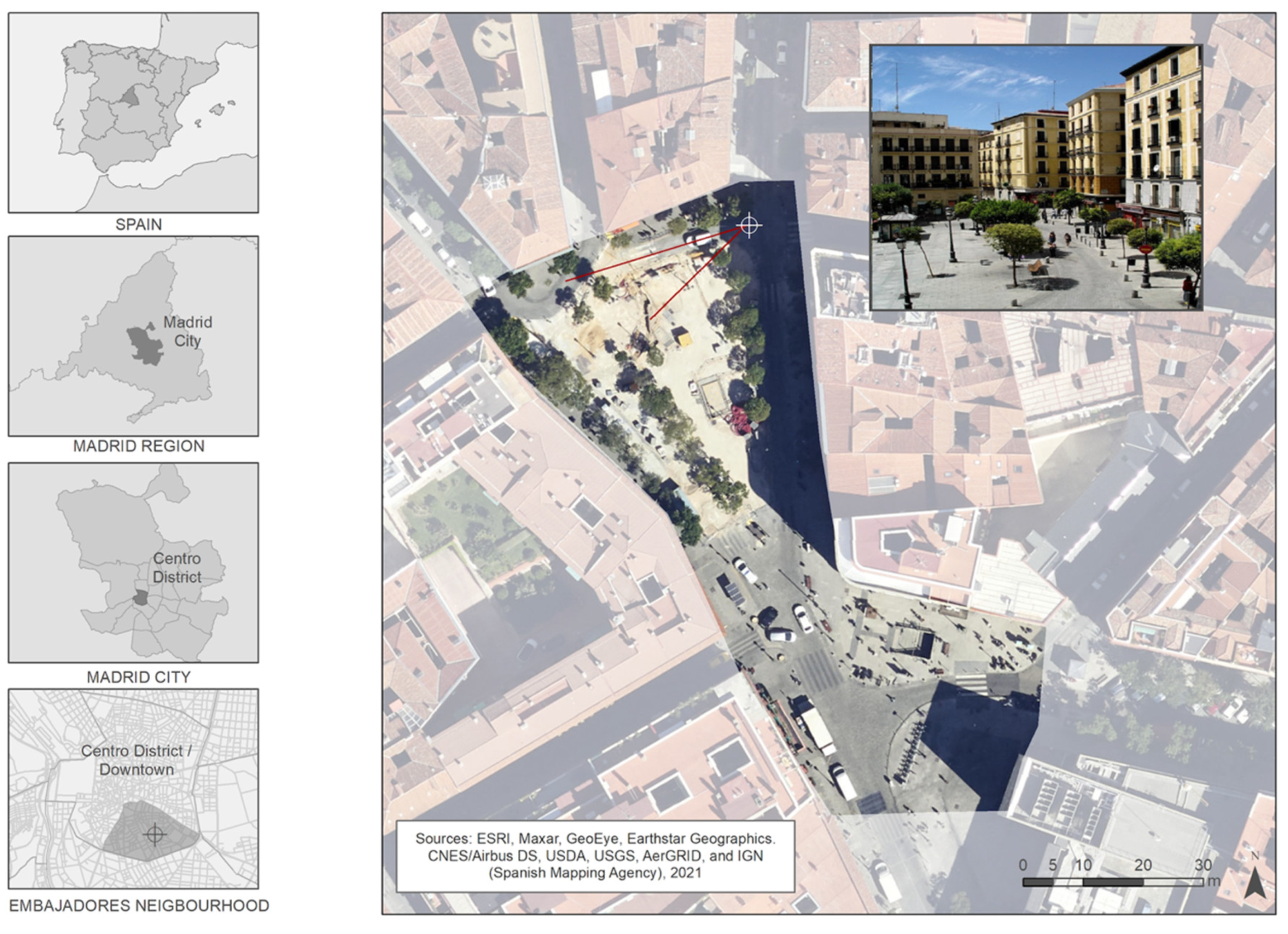
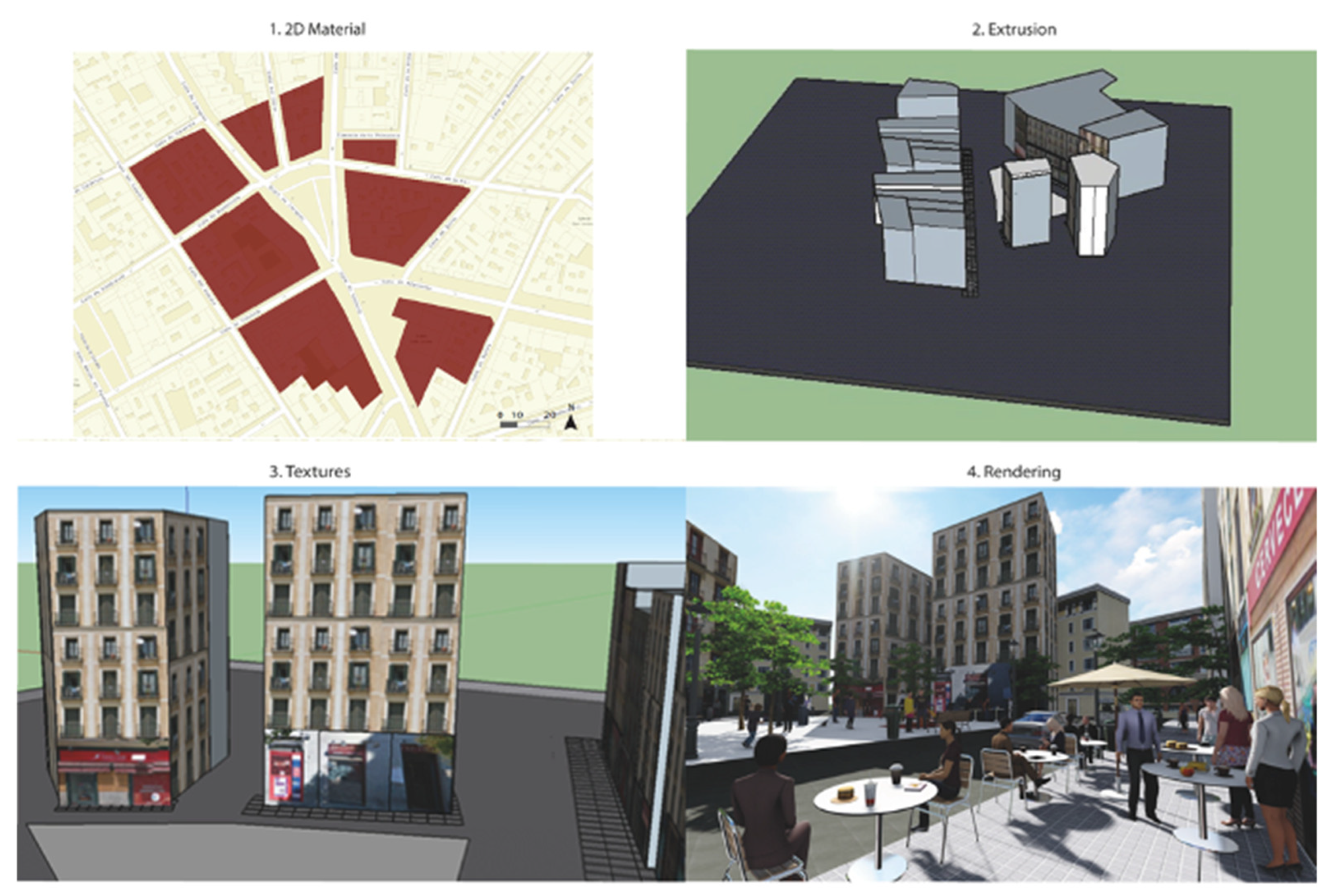

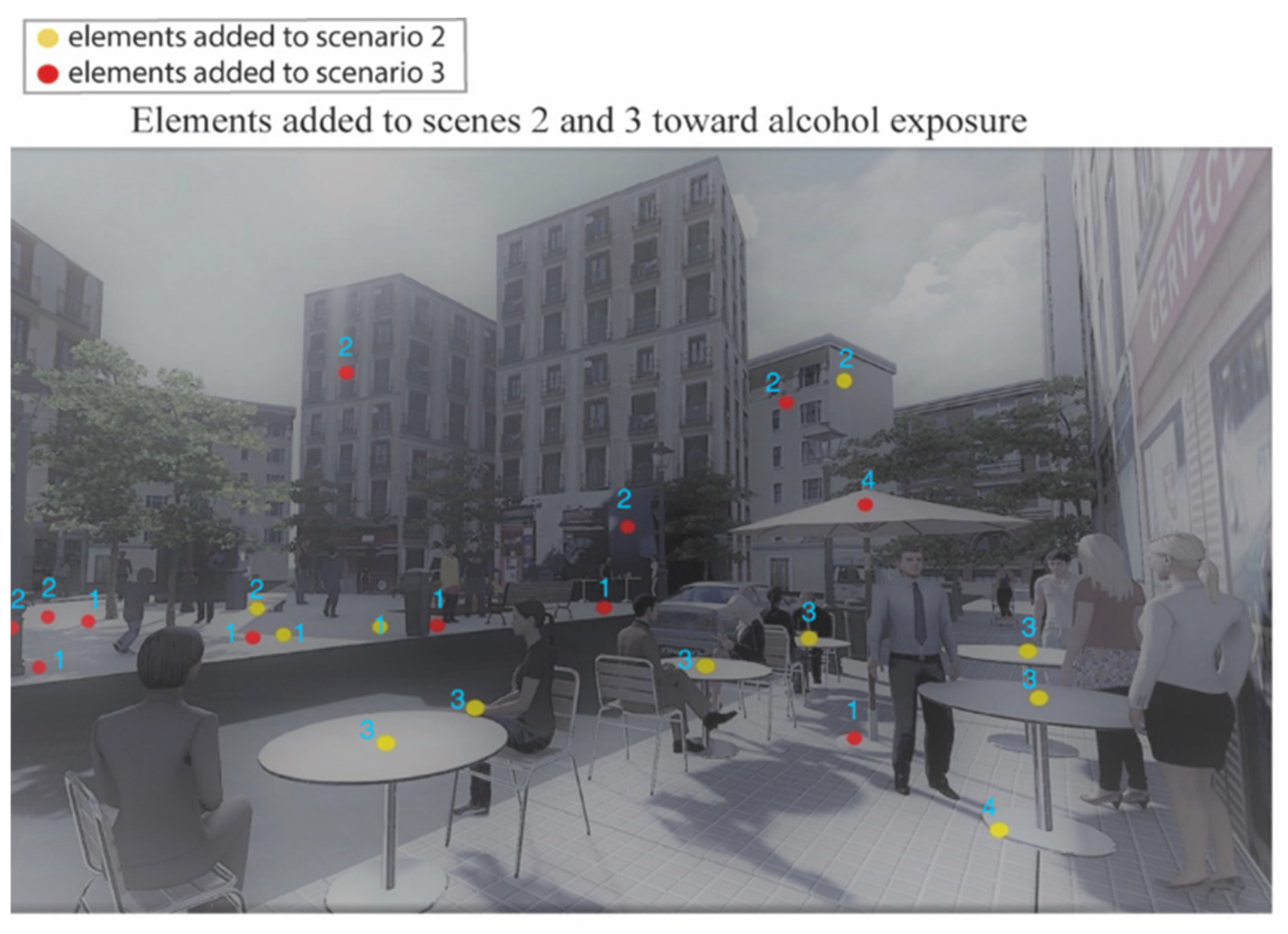
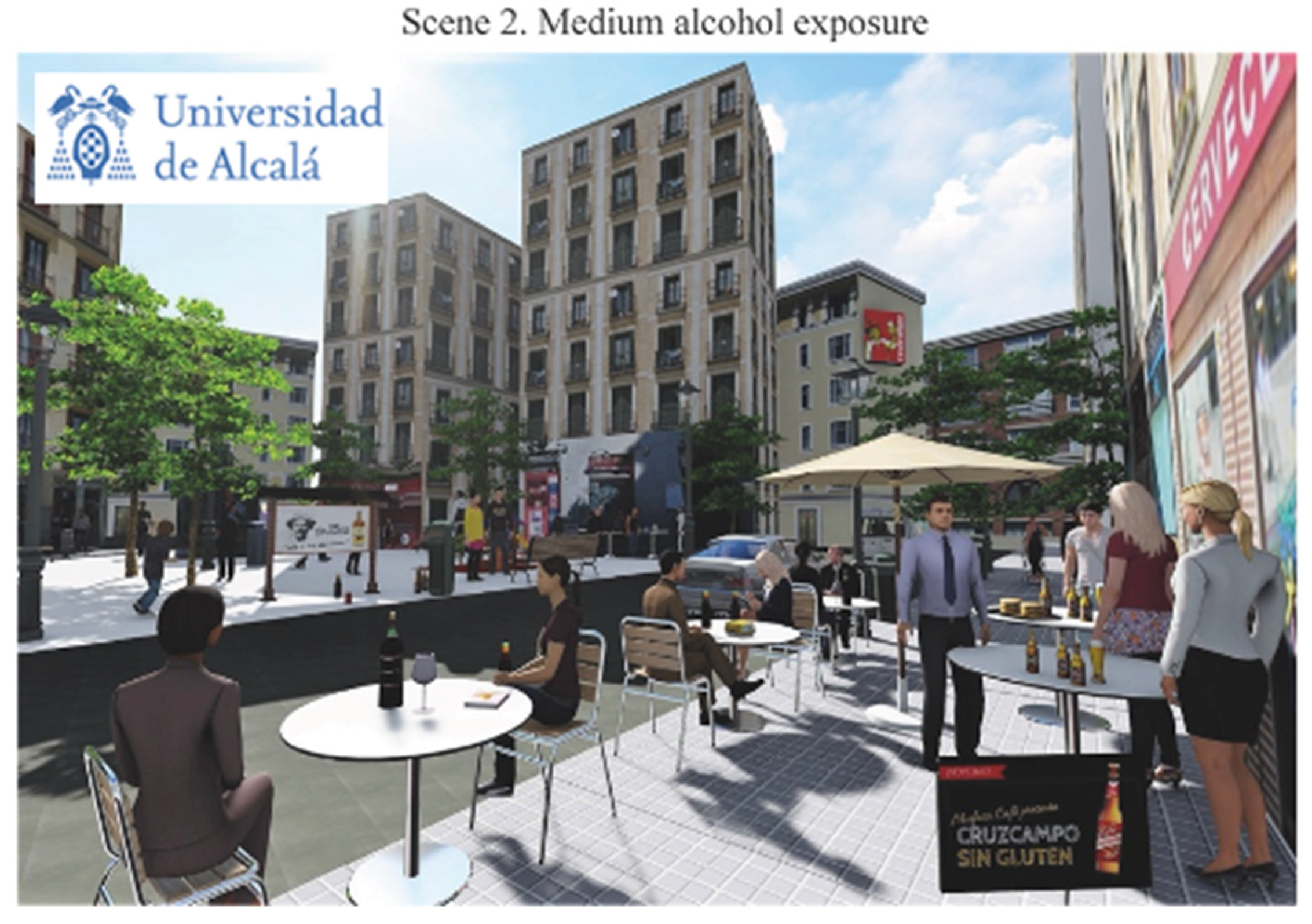
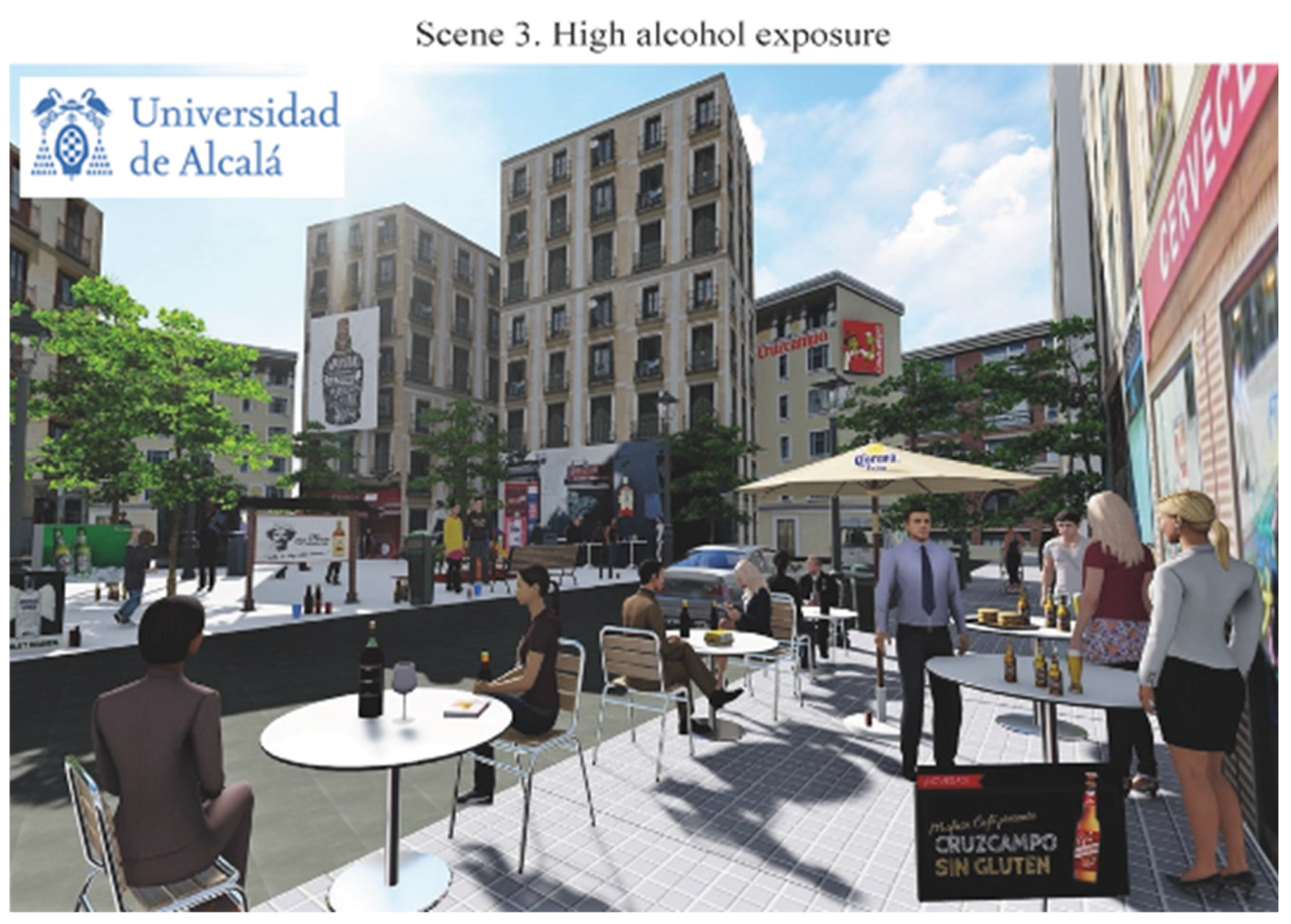
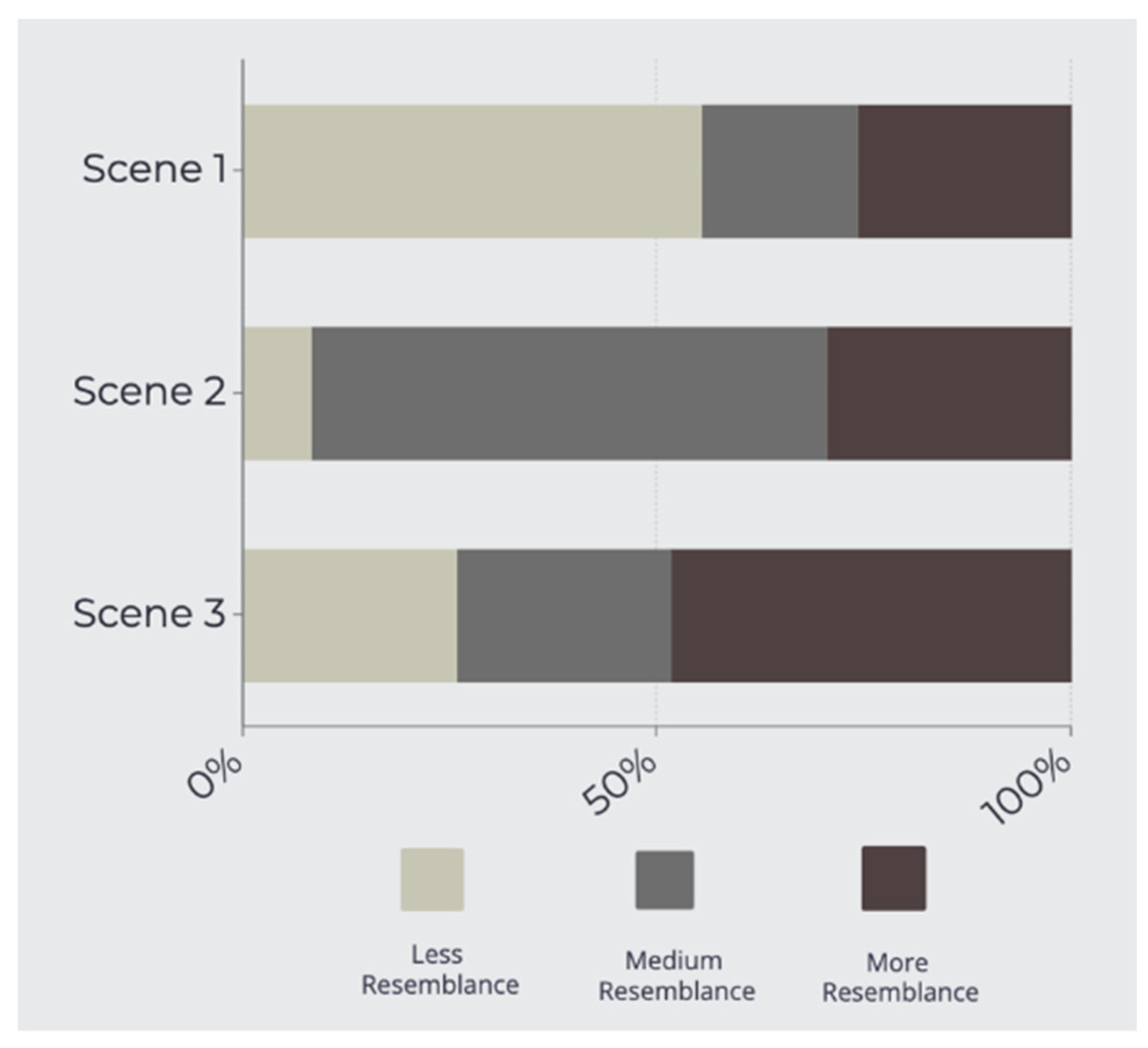
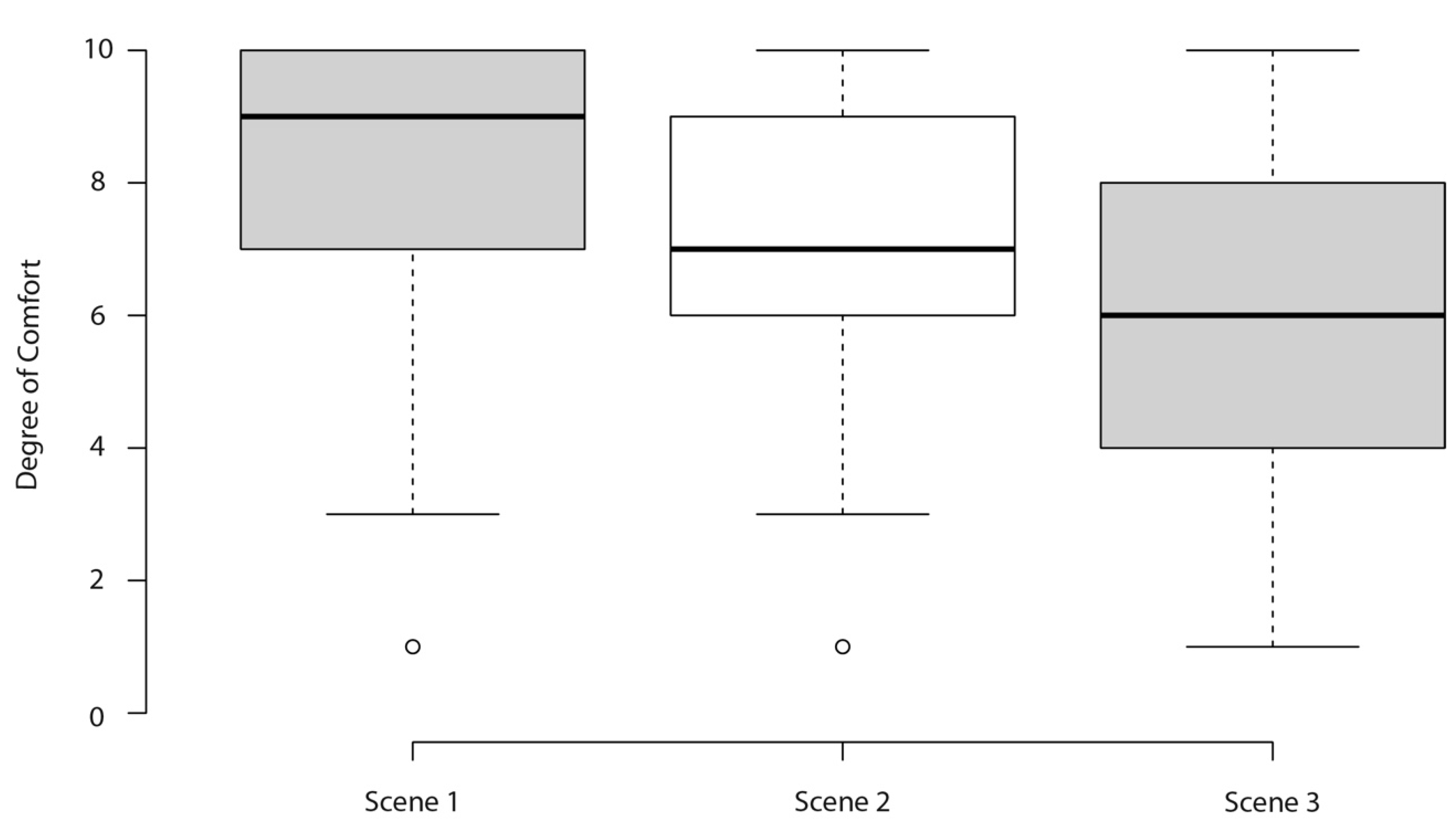
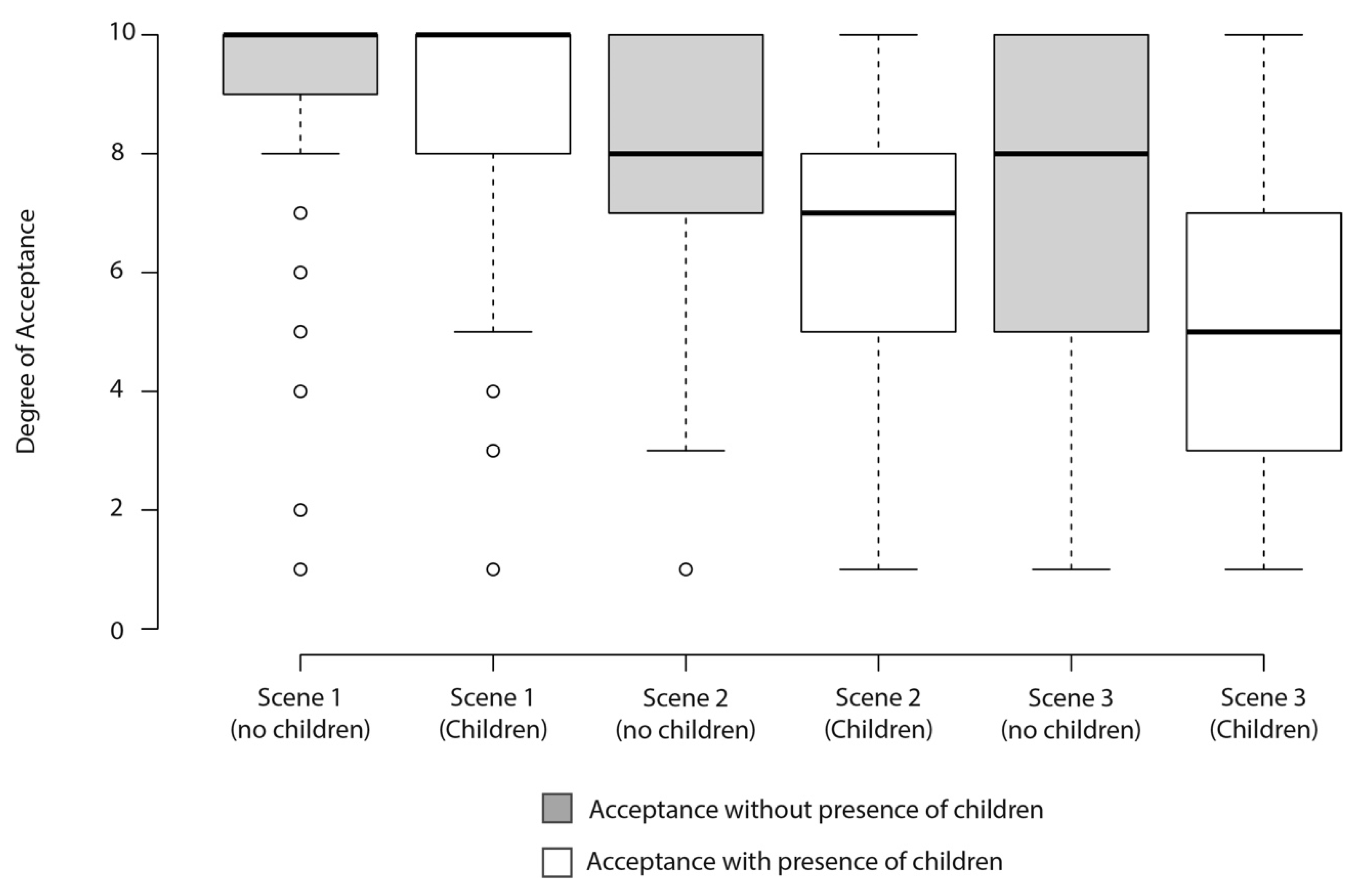
Publisher’s Note: MDPI stays neutral with regard to jurisdictional claims in published maps and institutional affiliations. |
© 2022 by the authors. Licensee MDPI, Basel, Switzerland. This article is an open access article distributed under the terms and conditions of the Creative Commons Attribution (CC BY) license (https://creativecommons.org/licenses/by/4.0/).
Share and Cite
Pastor, A.; Sureda, X.; Valiente, R.; Badland, H.; García-Dorado, M.; Escobar, F. Using Geovisualization Tools to Examine Attitudes towards Alcohol Exposure in Urban Environments: A Pilot Study in Madrid, Spain. Int. J. Environ. Res. Public Health 2022, 19, 9192. https://doi.org/10.3390/ijerph19159192
Pastor A, Sureda X, Valiente R, Badland H, García-Dorado M, Escobar F. Using Geovisualization Tools to Examine Attitudes towards Alcohol Exposure in Urban Environments: A Pilot Study in Madrid, Spain. International Journal of Environmental Research and Public Health. 2022; 19(15):9192. https://doi.org/10.3390/ijerph19159192
Chicago/Turabian StylePastor, Andrea, Xisca Sureda, Roberto Valiente, Hannah Badland, Macarena García-Dorado, and Francisco Escobar. 2022. "Using Geovisualization Tools to Examine Attitudes towards Alcohol Exposure in Urban Environments: A Pilot Study in Madrid, Spain" International Journal of Environmental Research and Public Health 19, no. 15: 9192. https://doi.org/10.3390/ijerph19159192
APA StylePastor, A., Sureda, X., Valiente, R., Badland, H., García-Dorado, M., & Escobar, F. (2022). Using Geovisualization Tools to Examine Attitudes towards Alcohol Exposure in Urban Environments: A Pilot Study in Madrid, Spain. International Journal of Environmental Research and Public Health, 19(15), 9192. https://doi.org/10.3390/ijerph19159192






